
National Geographic Magazine
Photography by Ronan Donovan, written by David Quammen
Exploring the relationship between humans and wolves in the Greater Yellowstone Ecosystem. This project began in 2014 while on my first assignment for National Geographic Magazine and continues to be a main focus of my storytelling work.
Yellowstone Wolves

I often wonder what it would be like to truly hear the language of the natural world. It's an endless joy for me to listen and to try to understand what the raven might be saying. A raven speaks on a frigid winter morning in Yellowstone National Park, Wyoming. “A teacher comes, they say, when you are ready. And if you ignore its presence, it will speak to you more loudly. But you have to be quiet to hear.” ― Robin Wall Kimmerer, Braiding Sweetgrass

Yellowstone sits atop an active supervolcano and is home to more than half of the world’s hydrothermal features. Castle Geyser, pictured here, erupts every 12 to 14 hours.

“The Apsáalooke people have always had a close relationship with the natural world. We understood that all of creation is meant to work together. Wolves were domesticated and used as beasts of burden by the Apsáalooke. The Apsáalooke held the wolves in high regard and treated them with respect. Apsáalooke scouts mimic the behavior of wolves in their activities while searching for the enemy.” – E M E R S O N B U L L C H I E F , P H . D .

The Grand Teton looms in the distance under a summer storm in Wyoming. While Yellowstone National Park was created for its geothermal areas, the actual land needed to sustain its wildlife and a healthy ecosystem is ten times the area of the park - Greater Yellowstone Ecosystem This vast ecological landscape encompasses ten times the area of Yellowstone National Park - 20 million acres vs the parks 2 million acres. The term 'ecosystem' applies to the ecological needs of the natural system in order to maintain biodiversity.

Wolves were systematically eradicated in the U.S. during the 19th century. The Yellowstone National Park Act of 1872 protected against “wanton destruction” in the park. Many wrongly believed that wolves would cause destruction by hunting game inside the park. By 1926, wolves were eliminated from Yellowstone by the National Park Service, with only the rare lone wolf wandering through the park for the next 70 years. Arizona Historical Society, Will C. Barnes Photographs, PC 10, Box 13, Folder 417, #5929 Additional information: Will Croft Barnes worked for the U.S. Forest Service in Arizona and New Mexico for 21 years, starting in 1907. The back of this photograph is captioned: "The January catch of Forest Service hunter T.B. Bledsaw, Kaibab National Forest, ca. 1914."
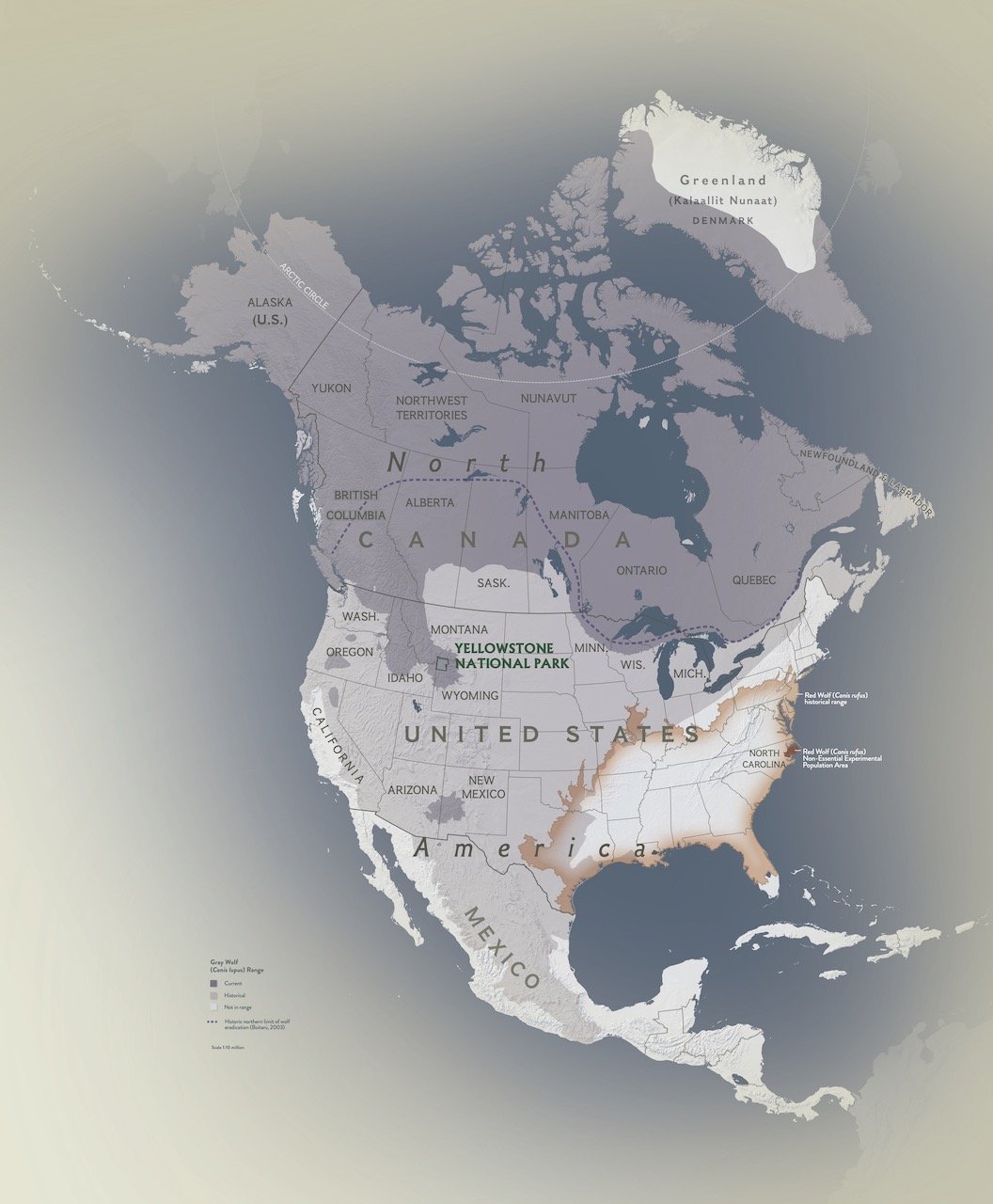
Range map of current and historic wolf range in North America by Martin Gamache of National Geographic Society.

An imprint in the snow is all that remains of a female wolf from the Mollie’s pack after her body was moved just out of frame for study by park scientists. Though the leading cause of death in Yellowstone is conflict with another pack, this wolf died of an infection.

On March 1, 1872, President Ulysses S. Grant signed the Yellowstone National Park Protection Act, establishing the world’s first national park as “a pleasuring-ground for the benefit and enjoyment of the people.” Among the stunning sights in the 2.2-million-acre park are geysers and colorful geothermal features, which are populated by heat-loving microorganisms that contribute to the kaleidoscope of colors found in the landscape.
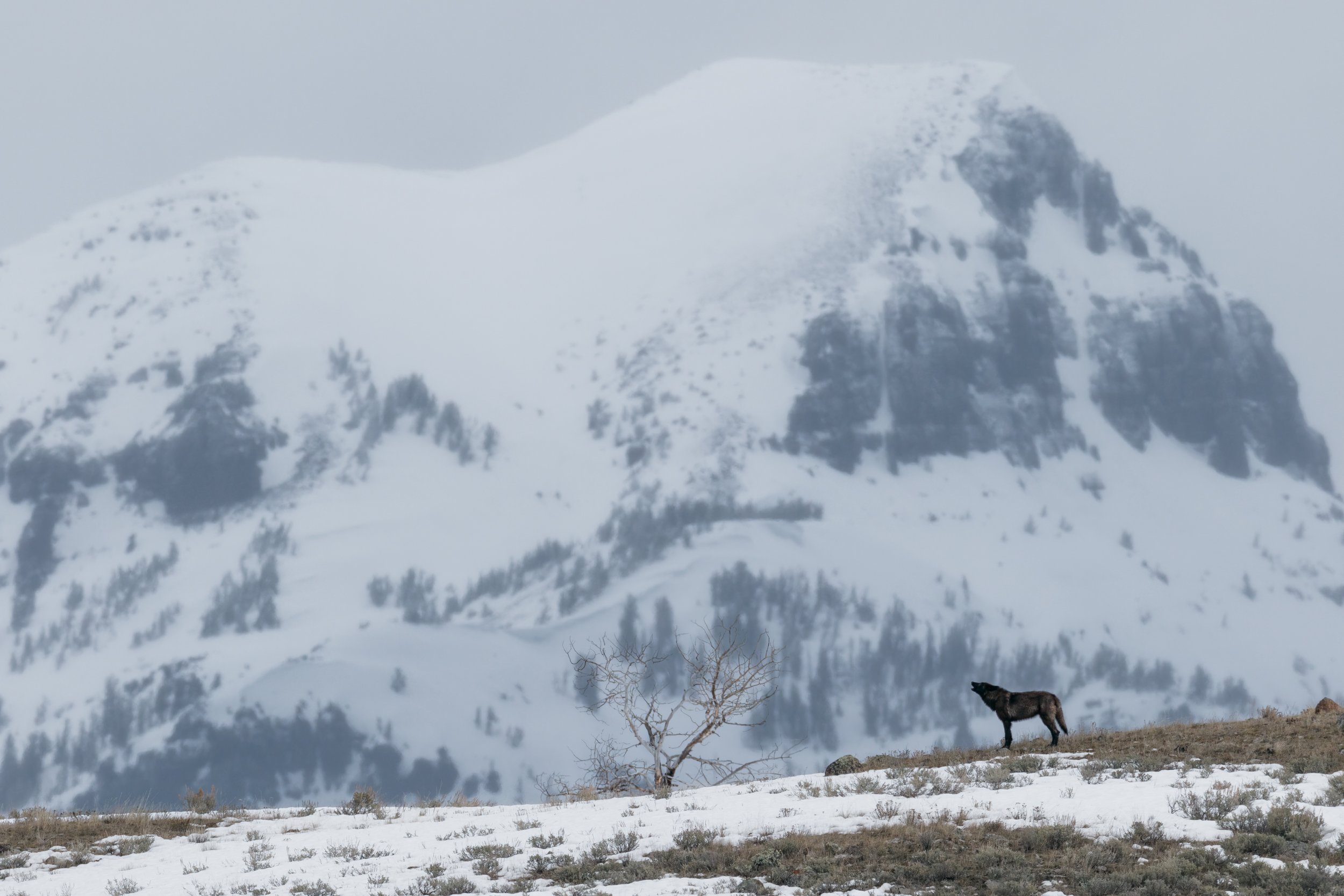
A wolf’s howl can travel as far as 10 miles (16 kilometers) in a vast, open landscape like Yellowstone National Park, Wyoming.
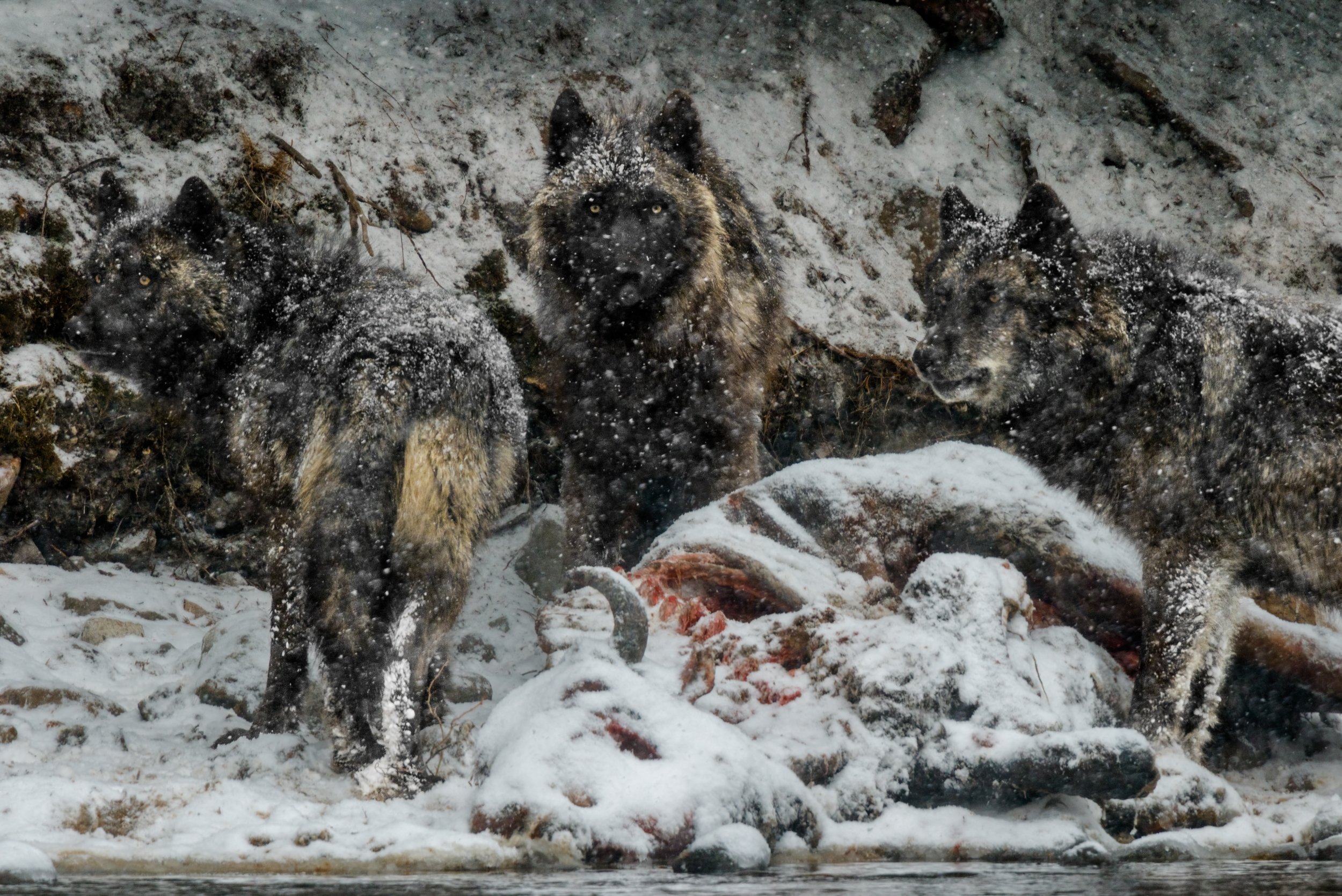
Although they are skilled hunters, wolves are not above taking advantage of a free meal. The matriarch of the Mollie’s pack, identified as 779F (right), closes in on the carcass of a drowned bison with other members of her pack. The largest female wolf ever recorded in Yellowstone, she lived to be eight years old—a ripe age for a wild wolf.

The Mollie’s pack, the only surviving pack dating back to the 1995 Yellowstone wolf reintroduction, counts Pelican Valley, pictured here, as a core part of its territory. In winter, this wild section of the Yellowstone plateau becomes a challenging place for survival, and the Mollie’s pack occasionally intrudes on other packs’ territories to find food.

A biologist shoots a wolf known as 980M using a tranquilizer gun from a helicopter. 980M, a five-year-old, 121-pound (55-kilogram) male, was the lead male of the Mollie’s pack at the time. A few minutes after being shot with a dart, 980M fell unconscious. Researchers then took measurements and samples and fit him with a new GPS tracking collar.

Scientist Doug Smith examines the body of wolf 980M. Seven months after being collared, 980M was killed while hunting an adult male elk. Hunting is dangerous: Fifteen percent of wolf deaths in Yellowstone happen while hunting large prey. Tracking collars emit a mortality mode after a wolf has not moved for several hours, leading staff to the location of the wolf.

Scientists Erin Stahler, Kira Cassidy, Dan Stahler, and Doug Smith collar three sedated wolves and collect samples for study. Over the past 27 years, researchers have collared over 500 wolves in Yellowstone.

In addition to studying individual wolves up close through blood draws and physical exams, researchers also study their habitats and territories. In this photo, scientist Kira Cassidy measures the height of a wolf den. This den was geothermally heated, which is a huge advantage to a pack with newborn pups which need to stay warm and dry.
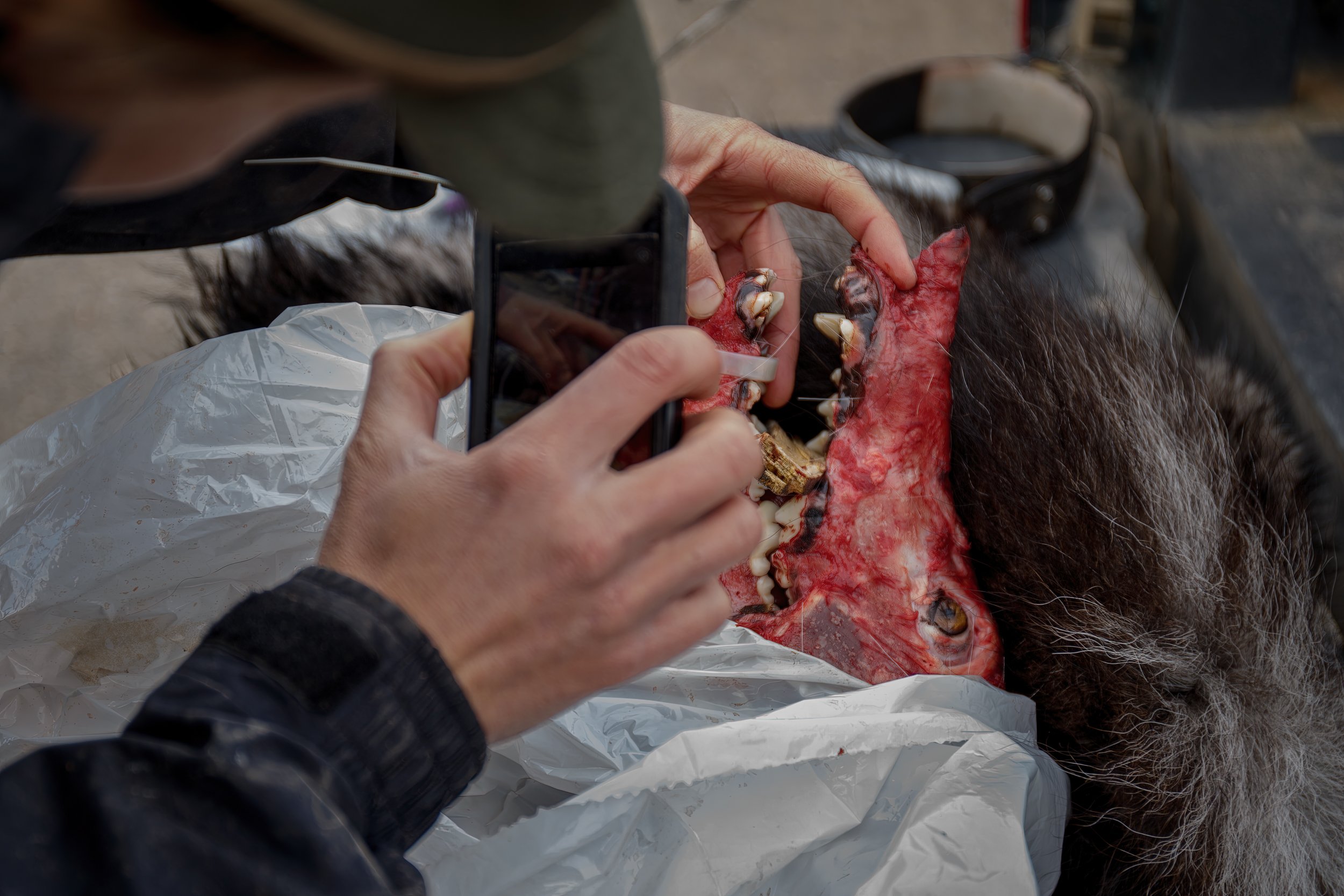
A scientist examines the remains of wolf 889F. 889F was legally killed by a hunter in Montana in 2014 after surviving a gunshot wound in 2013. Each year, approximately 25 percent of the wolves in the western U.S. are killed by hunters and trappers. In other areas of the country, wolves remain federally listed and protected.

A sedated wolf lies in the snow after being fitted with a new tracking collar. Over 500 wolves have been tracked using collars since the 1995 reintroduction of wolves to Yellowstone. The drugs used to sedate the wolves for these exams wear off within a few hours, after which the unharmed wolves rejoin their packs.

“Wolf watching'' is a big business for the Yellowstone region. Hundreds of thousands of people flock to the park hoping to get a glimpse of the elusive wolves, bringing tens of millions of dollars to the area annually. Wolf watchers spend long periods, sometimes months, observing and tracking wolves with the aid of binoculars and telephoto lenses.

This drowned bison sustained a grizzly bear for several days before a wolf, photographed using a camera trap, moved in to take advantage of an easy meal. Known as Mr. Blue for his steely blue-gray coat, this wolf outlived five mates over the course of his life.

Grizzly bears and wolves often feed on the same food sources. Here, a grizzly stands guard over the carcass of a drowned bison, which would later be shared by scavenging wolves. Bears can be aggressive scavengers: some are known to follow a wolf pack for weeks and, when the pack makes a kill, take over the prey before the wolves get a chance to eat.

Although they are skilled hunters, wolves are not above taking advantage of a free meal. The matriarch of the Mollie’s pack, identified as 779F (right), closes in on the carcass of a drowned bison with other members of her pack. The largest female wolf ever recorded in Yellowstone, she lived to be eight years old—a ripe age for a wild wolf.
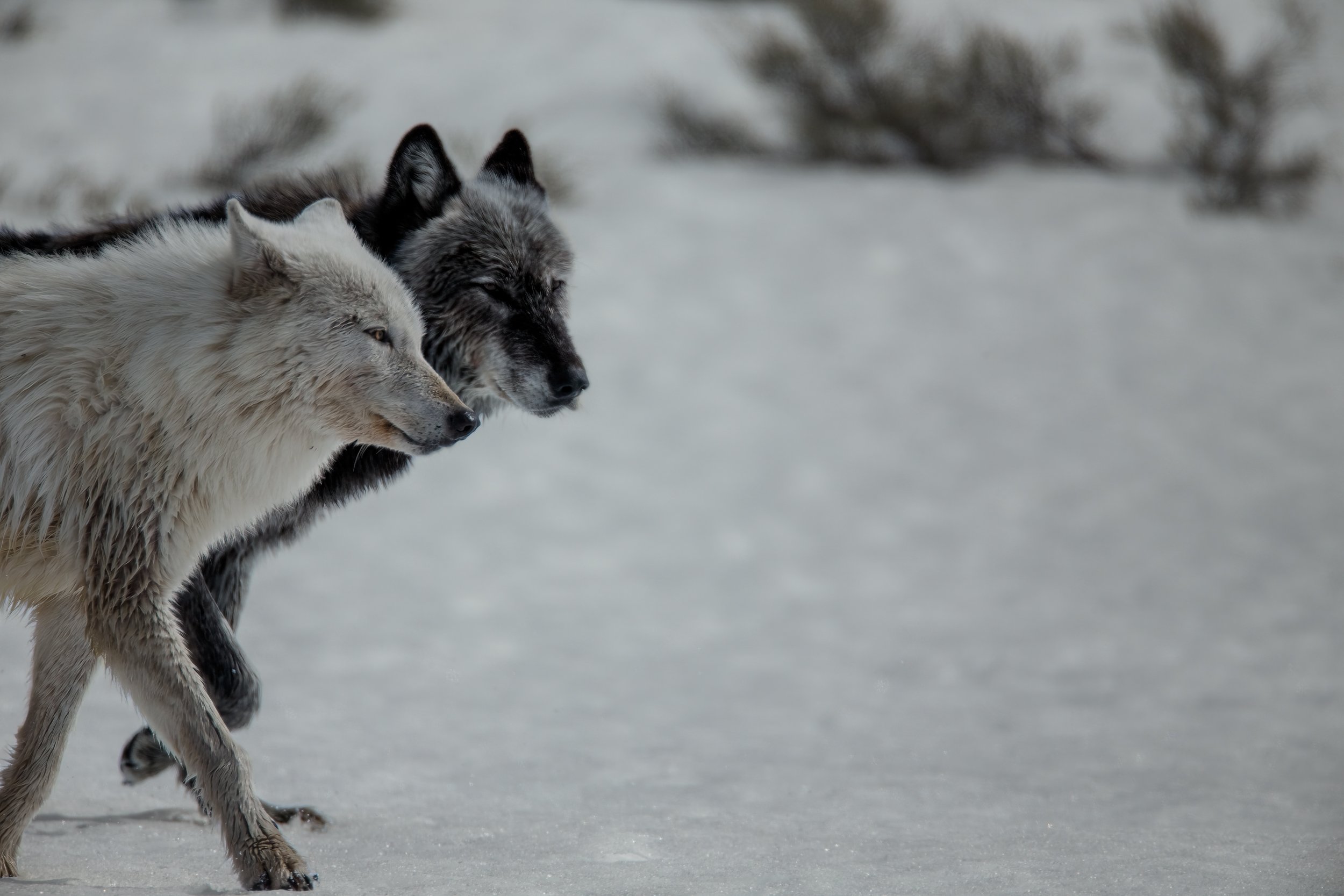
Two wolves, one with a white coat and one with a black coat, travel through the Hayden Valley of Yellowstone National Park. Though wolves in Yellowstone vary in coat color, they are all members of the species Canis lupus (gray wolf). These two were a bonded pair, leading Yellowstone’s Canyon pack together for nine years. The female was later illegally shot inside the park.

Yellowstone now has a healthy ecosystem of carnivores and prey. The bison population has recovered, which is another food source for wolves. Because bison are so large, smaller wolf packs have less success hunting them. The average pack is around nine wolves; it takes a pack of twelve or more to regularly target bison.

Wolves are an essential part of the Yellowstone ecosystem. When they were gone, the elk population soared. Without enough food to support those numbers, many elk starved in winter. As a result, National Park Service staff had to manage the elk population. Between 1930 and 1970, they killed or relocated an estimated 70,000 elk. Despite these efforts, the park’s northern elk herd reached close to 20,000 individuals in the early 1990s.

“In a traditional and historic sense, wolves and ranching do not mix. Since the paradigm of Manifest Destiny was imposed upon this land, ranchers have viewed wolves and “wildness” as something to fear, oppose, control and, often relentlessly, kill. The renewed presence of wolves on the western landscape is challenging us to rethink our relationship with them, and in doing so we are beginning to reimagine a new way of being in relationship with all of earth and with each other. As ranchers, our goal is no longer to tame, manipulate and suppress the natural world, but to celebrate and enhance life. All life.” – H I L A R Y Z A R A N E K

The Mollie’s pack investigates grizzly bear tracks in Yellowstone’s Pelican Valley. The only pack that remains from the wolf reintroduction in 1995, the Mollie’s pack was originally called the Crystal Creek pack. It was renamed in memory of Mollie Beattie (1947-1996), former director of the U.S. Fish and Wildlife Service and an instrumental figure in the reintroduction of wolves to Yellowstone.

A camera trap snaps a photo of a wolf from the Mollie’s pack walking by an elk skull, a remnant of the pack’s successful hunt two weeks earlier. During that hunt, the lead male of the Mollie’s pack, dubbed 980M by park staff, was kicked by the elk and killed.


